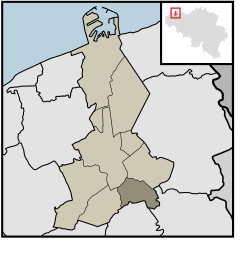Assebroek
Assebroek | |
|---|---|
 Abbey farm Saint-Trudo | |
 Location of Assebroek in Bruges | |
| Coordinates:51°11′47″N3°15′13″E/ 51.19639°N 3.25361°E | |
| Country | |
| Community | |
| Region | |
| Province | |
| Arrondissement | Bruges |
| Municipality | Bruges |
| Area | |
| • Total | 10.49 km2(4.05 sq mi) |
| Population (2014-12-31) | |
| • Total | 19,737 |
| • Density | 1,900/km2(4,900/sq mi) |
| Postal codes | 8310 |
| Area codes | 050 |
Assebroek(Dutch pronunciation:[ˈɑsəbruk]) is asub-municipalityof thecityofBrugeslocated in theprovince of West Flanders,Flemish Region,Belgium.It was a separatemunicipalityuntil 1971. On 1 January 1971, it wasmergedinto Bruges.[1]On 31 December 2014, Assebroek had 19,737 inhabitants. Since 1999, this number has hardly changed. Assebroek is home to 16.75% of Bruges’ population.
History
[edit]Through artifacts retrieved near Saint-Lucas hospital (and stored atGruuthusemuseumin Bruges) we assume that theLeitjeregion was already inhabited in theStone Age.
Aerial views of theVer-Assebroeksemeersenreveals an approximately 300 m-wide ring of ditches and rampart complex dating from the 5th century where the lords of Assebroek later built their castle.
Apparently around the 12th century, a lord calledBoudewijn of Assebroekbought his domain – limited byOostkamp,Oedelem,Michel van Hamme street, Astridlaan and Lorreinendreef - free fromSijsele.
The Assebroek municipality only consisted of some scattered maisonnettes and amillalong the old road toBruges.Instigated by thelords of Assebroek,a local church andEngelendaleconvent were established.
Nowadays Assebroek includes 6 parishes:Immaculata(Ver-Assebroek),Assumpta,Saint Lutgardis,Saint Catharina,Saint Christopher,andSacred Heart(Steenbrugge).
Etymology
[edit]Before the 20th Century, the town's name was recorded asArs(e)brouc,later becomingAssebroek.
Ars(e)broucprobably meantwetland with horses.The medieval DutchArseorOrsbeinghorsesandbroucmeaningmarsh.In medieval times, theMeersenarea was surrounded by several inns all bearing horsenames of which only the ruin ofThe Flying HorseinOedelemis still standing. Some sources claimArsestands forashesso thatAssebroekwould meanmarsh surrounded by ashes.
Geography
[edit]Assebroek is situated on a lower sand plain south west of Bruges. Forming a typicalpolderlandscape, in winter an area calledAssebroekse Meersen,characterised by small grass fields separated bywillowtrees often gets flooded.
TheMeersen areaarose as prolongation within the so-calledFlemish Valley.The slope containssand,limeandpeatdeposits from theHoloceneEpoch. Underneath the peat remains an approx. 30 cm marsh lime layer from the early Holocene. 10,000 years ago, this region was a realmarsh.
Evolution of the number of inhabitants
[edit]19th century
[edit]Census results of December 31
| Year | 1806 | 1816 | 1830 | 1846 | 1856 | 1866 | 1876 | 1880 | 1890 |
|---|---|---|---|---|---|---|---|---|---|
| Number of inhabitants | 543 | 614 | 845 | 1,186 | 1,171 | 1,259 | 1,493 | 1,599 | 1,915 |
20th century till rearrangement of municipalities
[edit]Census results of December 31
| Year | 1900 | 1910 | 1920 | 1930 | 1947 | 1961 | 1970 |
|---|---|---|---|---|---|---|---|
| Number of inhabitants | 2,733 | 4,705 | 5,456 | 6,936 | 11,337 | 14,422 | 15,572 |
Attractions
[edit]- Local church of Ver-Assebroek with organ (Pastoor Verhaegheplein)
- Reserve 4.2 km2"Assebroekse Meersen" with concentric rings (Kerkdreef)
- 19th century village centre (Generaal Lemanlaan)
- Cemetery of Bruges – a.o. tomb ofGuido Gezelle(Kerkhofblommenstraat)
- Bergjesbos (Olmendreef)
- Former inn "The Lily" (Weidestraat)
- Children's farm "The Seven Towers" (Canadaring) (NL = Zeven Torentjes)
- Old barn "Het Leenhof" (Kerklaan)
- Convent domain "Engelendale" (Astridlaan)
- Abbey farm "Saint-Trudo" (Sint-Trudostraat)
- Reserve 400,000 m2"Gemene Weidebeek" (Gemene Weideweg)
- Kasteel Zevecote (Bossuytlaan)
Assebroek - a sacred place
[edit]Each year thousands ofpilgrimshonour the miraculous figurine ofThe Madonnaat Ver-Assebroek and pray with theBenedictinemonks of Steenbrugge. According to thelegend(represented by the stained-glass windows in the church) this marble figurine floated when theGeuzenthrew it into the sea.
Assebroek beer community
[edit]In medieval times, the inner city of Bruges imposed significant taxes onbeerconsumption. Hence so calledoutside drinkersfound their way to Assebroek's inns till the early morning when Bruges’ city gates were opened.
Many beers are named after this place (Steenbrugge Blonde,Steenbrugge Double Brown,Steenbrugge TripleandSteenbrugge White) or were locally brewed by theRegenboog Brewery(now moved toMater).
Gallery
[edit]-
O.-L.-V.-Onbevlekt- Ontvangenkerk
-
O.-L.-V.-ten-Hemel- Opgenomenkerk
-
Sint-Jozef en Sint-Christoffelkerk
-
Sint-Katharinakerk
-
Assebroekse Meersenwith in the background the church of Ver-Assebroek
-
Former innDe Lelie(17th century)
-
TheAssebroekse Meersen
-
TheBergjesboscastle
-
The Seven Towers (NL = Zeven Torentjes)
-
Abbey farm Saint-Trudo
-
Gemene Weidebeek
-
Gemene Weidebeek

















